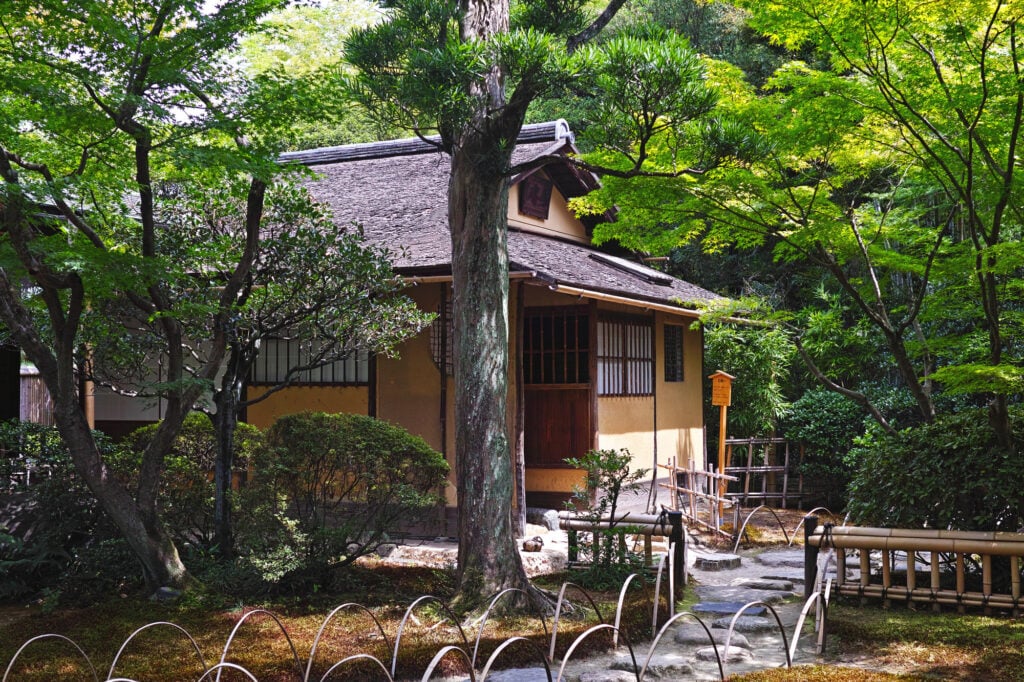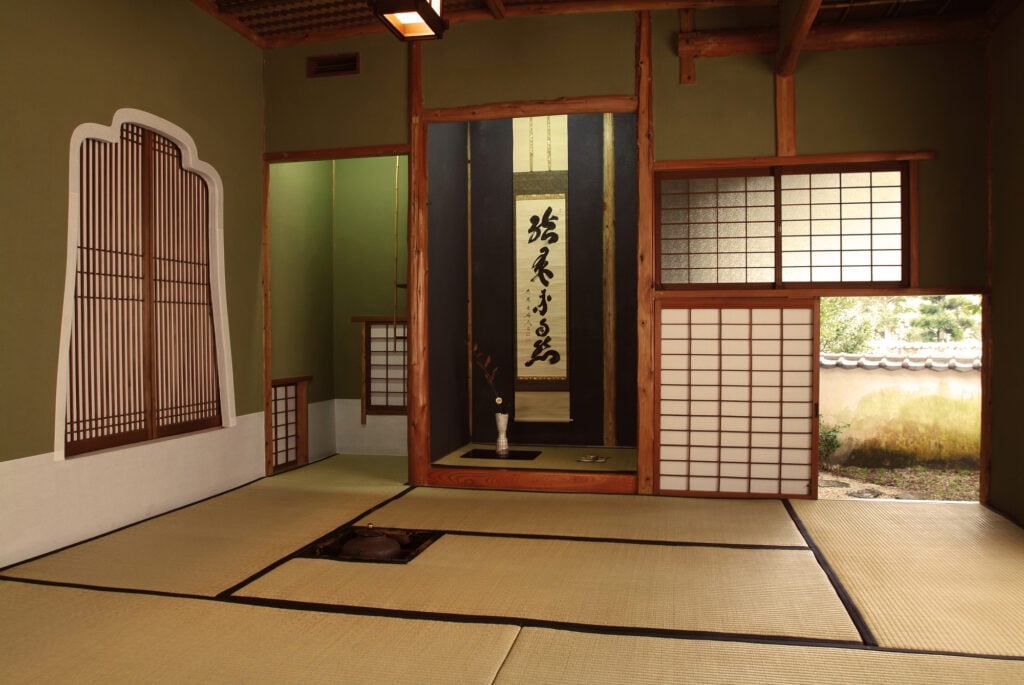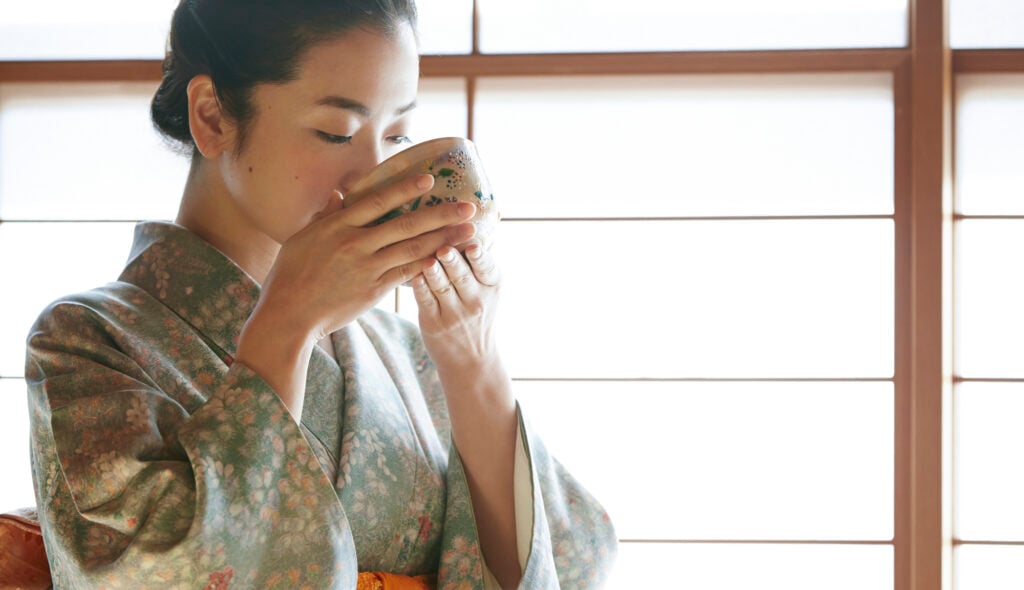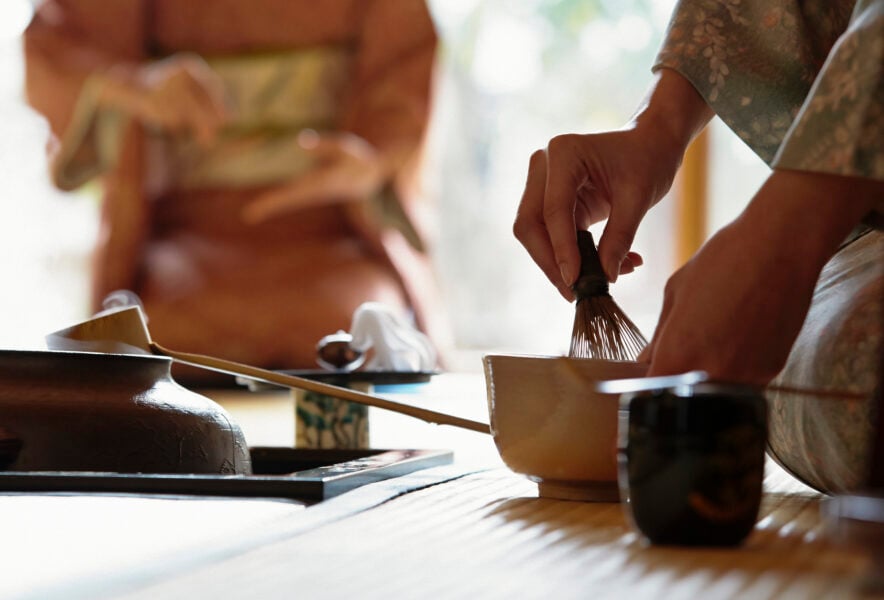The tea ceremony is one of Japan's representative traditional cultures. With the spread of the concept of wabi-sabi and the popularity of Japanese tea, the tea ceremony has become known throughout the world.
In Tokyo and other cities, there are many hands-on tea ceremony classes for foreigners.
In this issue, we will explain the basic concept and specific manners of the tea ceremony in an easy-to-understand manner.
What Is the Tea Ceremony?
The tea ceremony is an act (ritual) in which the host invites guests into the tea room and entertains them by serving them tea in accordance with certain manners.
The invited guest is also expected to act in accordance with the etiquette.
The purpose of the tea ceremony is not the etiquette itself, but the spiritual exchange. The etiquette is merely a means to that end.
The meaning of the etiquette cannot be understood without knowing the purpose and fundamental ideas of the tea ceremony.
Therefore, before introducing detailed etiquette, we will first summarize the purpose and concept of the tea ceremony in an easy-to-understand manner.
Roots and Purpose of the Tea Ceremony
The best way to understand the purpose and concept of the tea ceremony is to know its roots.
The roots of the current tea ceremony can be found in Wabicha, which Sen no Rikyū developed into a great masterpiece.
And Sen no Rikyū's Wabicha has its roots in the tea ceremony of Murata Jukō.
During the Muromachi period (1336-1573), when Murata Jukō lived, chanoyu (tea ceremony) was popular among aristocrats (court nobles and warriors) who entertained guests by serving tea (powdered green tea) in a certain manner.
The tea ceremony of the aristocrats consisted of serving tea using expensive Chinese tea bowls in a building built in a corner of the aristocrats' residence and enjoying gorgeous banter.
The tea master Murata Jukō, who was also a Buddhist monk, disliked this practice.
He created and practiced the chanoyu method of tea ceremony, in which tea is served in crude tea bowls and guests quietly mingle with each other in a crude hermitage built in the middle of nowhere.
This method developed through his disciples, and was later refined into the wabicha style by Sen no Rikyū.
While Murata Jukō lived in seclusion in a remote area, Sen no Rikyū built a tea house in the city that resembled a hermitage, where he practiced chanoyu.
Sen no Rikyū's tea room was rather small, about 2 to 3 tatami mats in size, with no ornate decorations and simple utensils for serving tea.
He created an extraordinary space by controlling the light that shone into the tea room through special design and by elaborating on the path leading to the tea room.
Murata Jukō and Sen no Rikyū valued simplicity more than anything.
They believed that the glamorous world full of things and people was noisy and vain, and that genuine beauty and spiritual satisfaction could be found only through simple living and interaction in a simple tea room.
The tea ceremony follows Sen no Rikyū's method, in which working people gather in a special space called a tearoom to hold a tea ceremony (chakai), with the host and guests acting as the tea masters.
The purpose of the tea ceremony is to enhance each other's spirit through extraordinary exchanges.
“Wabi-Sabi” and “Wakei Seijaku”
Murata Jukō and Sen no Rikyū avoided material wealth and glamorous interactions, pursuing a modest lifestyle and the elegance that can only be found in a simple environment.
This way of life and state of mind is called “wabi”.
Newly built houses and tools become old with time, and places that were once lively become deserted, but at the same time, they take on a calm and deep atmosphere.
This atmosphere is called “sabi”.
The tea ceremony emphasizes the “wabi” and/or “sabi” atmosphere. Many elements of the tea house and tea ceremony are constructed based on “wabi-sabi,” and they exist so that the owner and guests can pursue “wabi-sabi”.
Along with “wabi-sabi,” the tea ceremony emphasizes the concept of “和敬清寂 wakei seijaku” (harmony, respect, cleanliness and tranquility).
- 和 (Wa = Harmony): to be at peace with one another and harmonize
- 敬 (Kei = Respect): to honor one another.
- 清 (Sei = Cleanliness): to keep the mind and the space of the tea room pure.
- 寂 (Jaku = Tranquility): to be quiet minded and unperturbed by anything
These are the elements necessary to make a tea ceremony meaningful, and together with “wabi-sabi,” they are the goals that should be pursued.
“Ichiza-Konryu” and “Ichigo-Ichie”
The master of the tea ceremony offers tea in a variety of elaborate ways to entertain his or her guests, and the guests, while respecting the master and the other guests, take the initiative in creating the atmosphere of the occasion.
The resulting comfortable sense of unity in the tearoom space is called "ichiza-konryu," and is one of the goals of the tea ceremony.
At a tea ceremony, everyone is expected to be attentive to the spirit of "ichigo-ichie," meaning "one life, one meeting," and to be mindful of "ichiza-konryu".
The concept of "ichigo-ichie" is that each encounter is a once-in-a-lifetime encounter that will never happen again, and therefore, each encounter should be treated as if it were the last.
The basic idea of the tea ceremony is that both the master and the guests should cherish each encounter as an irreplaceable opportunity to build a tea ceremony house.
Major Schools of Tea Ceremony
Sen no Rikyū's Wabicha was passed down to his disciples, including his descendants, but due to differences in the ideas of his disciples, the tea ceremony has been divided into many schools.
Today, there are said to be more than 500 different schools of tea ceremony, the most representative of which are Omotesenke, Urasenke, and Mushanokoji Senke, collectively known as the Three Senke Schools.
These schools were started by the sons of Sen no Rikyū's grandson.
The etiquette of the tea ceremony differs slightly from one school to another.
Chaji and Chakai
There are two types of meetings in the tea ceremony: "chaji" (tea ceremonies) and "chakai" (tea gatherings).
- Chaji: A meeting where not only tea but also kaiseki cuisine is served to a small group of people invited by the master of the tea ceremony.
- Chakai: A tea ceremony is a gathering where only tea is served, and can range from a small group to several hundred people, many of whom can attend on the same day without an invitation.
Beginners generally start with a tea ceremony.
The Flow of a Tea Ceremony and Basic Tea Ceremony Etiquette
The following is an introduction to etiquette on the part of the guest, following the flow of a tea ceremony. The details of tea ceremony etiquette differ from school to school, but this section omits those details and focuses only on the general etiquette.
Clothing and Personal Belongings
Dressing in kimono and white tabi (tabi socks) is the basic attire for tea ceremonies, but in many cases, the host of a tea ceremony may allow people to wear western clothes.
Even if you choose to attend in Western clothing, be sure to wear formal attire in subdued colors.
Also, be sure to wear white socks.
Wearing white tabi socks and white socks is a rule that follows the "sei" in "wakei-seijaku".
No metal jewelry or watches may be worn.
This is to avoid scratching the tea utensils.
There are a variety of utensils to bring to a tea ceremony, but for beginners it is sufficient to prepare three items: a fan, kaishi (tea paper), and kashikiri (a small piece of paper for confectionery) (some tea ceremony organizers provide basic utensils).
- Sensu (folding fan): A small fan used for greetings and other such occasions (you do not open it to fan yourself)
- Kaishi: Paper used as a plate for receiving sweets or for wiping a bowl of tea
- Kashikiri (large toothpick): a tool used to cut confections into bite-size pieces or to stick them into confections to bring them to the mouth.
Entering the Tea Ceremony Room

The tea ceremony room is accessed through an open area (garden) paved with stepping stones (paving stones). There is a water basin outside the entrance to the tea room, so wash your hands there before entering.
There are cases where the master of the tea ceremony has already entered the room, and other cases where the master of the tea ceremony does not enter the room until after the tea is prepared.
If the master of the tea ceremony has already entered the room, you should say "excuse me" before entering.
The entrance to the tea room is so small that one must bow one's head to enter.
This was Sen no Rikyū's idea, and everyone (even the nobles of the samurai and court nobles of the time) had to bow their heads (and remove their swords if they were warriors) to enter the tea ceremony room.
This system incorporates the idea that "everyone is equal in the tea room".
Equality is the basis of the "wa (harmony)" and "kei (respect) in "wakei-seijaku".
Admire the Hanging Scrolls in the Tokonoma (Alcove)

After placing a fan in front of one's knees and bowing, visitors are invited to view the hanging scrolls, flowers, flower vases, and other decorations in the tokonoma (alcove).
The alcove decorations, tea bowls, and other tea utensils are prepared by the proprietor for each tea ceremony, and are chosen according to a theme conceived by the proprietor.
Seating
The representative of the guests (seikaku) sits closest to the master.
The seikaku, representing the guests, converses with the host, asks questions about the tea ceremony and tea utensils, and leads the tea ceremony together with the host.
During the entire tea ceremony, all guests except for the seikaku do not speak with the host, but only greet him or her.
The theme of the day's tea ceremony is gradually revealed through the conversations between the guests and the host.
The person who sits farthest away from the hostess is called the "makkyaku", and has the important role of helping the tea ceremony progress, which is performed by experienced tea masters.
Beginners sit between the seikaku and the makkyaku.
The basic rule is to sit in seiza on the tatami mats, but there may be no problem with sitting on the floor, etc., depending on the gathering.
There are also tea ceremonies called taterei-shiki, in which tea is served at a table while sitting on a chair.
Greetings
After being seated, greetings are exchanged between the host and guests, and between guests.
The order of greetings changes depending on when the master enters the room, but beginners are fine as long as they wait to be greeted and respond to the greeting.
When greeting, place the fan in front of your knees and bow.
Receiving Sweets
While tea is being prepared, sweets are served.
In some cases, a bowl with sweets for everyone is passed around in turn, while in other cases, a bowl with sweets for one person is handed out.
In the latter case, the participants bow to receive the sweets.
When the bowl of sweets is passed around, when it is your turn, say to the person next to you, "After you," then take out a piece of kaishi paper, take one of the sweets, and place it on the kaishi paper.
The main confectionery (fresh confectionery made of bean paste, rice cake, etc.) and dried confectionery (such as rakugan, sembei, kompeito, etc.) are served. The fresh confectionery is taken by picking it up with the chopsticks attached to the bowl, and the dried confectionery is taken by hand.
After the sweets have been taken, the bowl is passed to the person next to you.
When all the sweets have been passed around, the master will say, "Please take the sweets," and bow before starting to eat them.
The main confectionery is cut into small pieces and eaten.
Receiving Tea

There are two types of tea: thick and thin. Koicha is a thicker tea that is passed around a little at a time.
Usucha is thin tea made for one person at a time, and the tea served to you is all consumed.
At a tea ceremony, both types of tea are served, but at a tea party, only either koicha or usucha is served in most cases.
When it is your turn to drink, you greet your neighbors before drinking.
First, place the tea bowl between yourself and the person whose turn comes before you and say, "I will accompany you," and then move the bowl between yourself and the next person whose turn comes after you and say, "After you".
Then, return the tea bowl to your front and greet the master of the tea ceremony with "I will have the tea bowl before you", take the tea bowl with your right hand, place it on your left hand, and lift it up with your right hand.
From this point on, the etiquette differs slightly from school to school, but beginners should be especially aware of the following points.
- Turn the tea bowl slightly so that the front of the bowl is not in contact with the mouth (drinking with the front of the bowl off is an expression of modesty and respect for the host).
- Drink only your portion of the tea in a few sips for Koicha and all of it for Usucha.
- For usucha, wipe the mouthpiece with your finger; for koicha, wipe with a piece of kaishi paper.
- Put the tea bowl down and appreciate it (you can hold it in your hand as well).
- For usucha, the tea bowl is returned to the person who finished it; for koicha, the tea bowl is passed to the next person.
Greetings and Exiting
When everyone has finished drinking the tea and admiring the bowls, the tea ceremony ends with a closing speech by the master of the tea ceremony and the regular guests.
About the Tea Ceremony Experience Class for Foreigners
Many tea ceremony schools in the Tokyo metropolitan area, Kyoto, Osaka, and other areas offer hands-on tea ceremony classes for foreigners visiting Japan.
Some offer classes in English, Chinese, and Korean, and others allow you to sit in a chair and experience the tea ceremony.
Clothing is optional, but it would be fun to participate by changing into Japanese clothes with a kimono rental service.
In Conclusion
Although etiquette is not the purpose of the tea ceremony, it is useful to start with etiquette (form) without thinking about the purpose or reason, in order to learn about traditional Japanese culture.
If you visit Japan, we recommend that you participate in a casual tea ceremony or a hands-on tea ceremony class.

